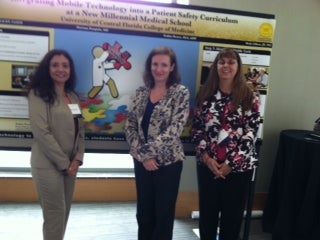One of the AAMC’s current initiatives is “Best Practices for Better Care,” a multi-year initiative to improve the quality and safety of health care.
A College of Medicine team presented one poster on the use of technology to improve patient safety. Dr. Bethany Ballinger, an Orlando emergency physician and assistant professor of emergency medicine and clinical informatics, Nadine Dexter, director of the Harriet F. Ginsburg Health Sciences Library, and Dr. Mariana Dangiolo, professor of family medicine, highlighted the college’s use of iPod touches. The hand-held devices contain Epocrates, a drug database of over 3,300 drugs. The poster explained how medical students use their iPods to identify potentially dangerous drug interactions for patients they see during their training with local doctors. In addition, College of Medicine students use Geriatrics at Your Fingertips software on mobile devices as they work with senior patients.
Another AAMC poster, co-authored by Dr. Ballinger, showed how the College of Medicine became the first American medical school to initiate the World Health Organization’s (WHO) patient safety curriculum. The WHO identifies 11 areas that are key to improving patient safety, including infection control, surgery, medication and practical ways to analyze how mistakes are made.
Patient safety is one of the College of Medicine’s Longitudinal Curricular Themes (LCTs), interdisciplinary topics interwoven into the four-year curriculum. And the college’s message at the AAMC was that topics like patient safety must be emphasized at every turn.
“Safety is such an important thread in the curriculum,” said Dr. Ballinger said, who is director of the patient safety LCT. “You can’t just have a course on patient safety for three days and then be done with it. Patient safety must be a part of everything you do.”
